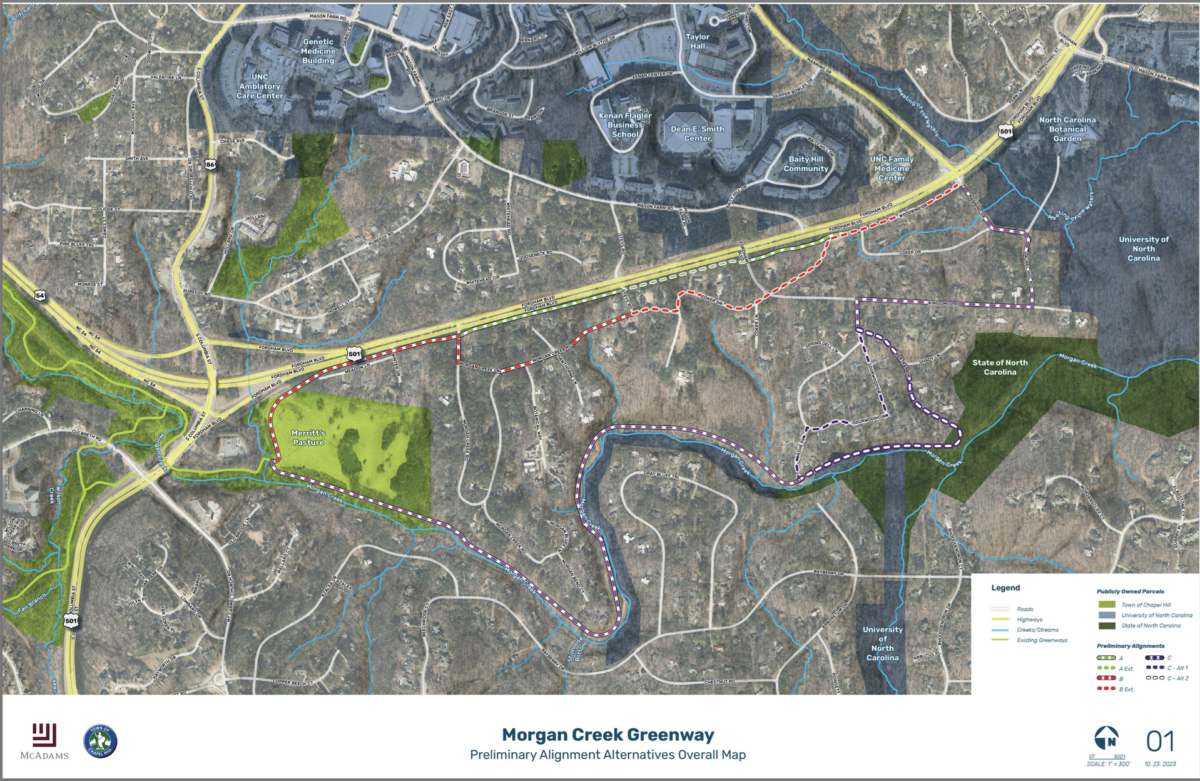Merritt’s Pasture is one of Chapel Hill’s hidden treasures. Set at the intersection of NC 54 and US 15-501, a mile down the hill from UNC Hospitals, Merritt’s Pasture is a respite from a busy section of town. There are no sports fields, no picnic tables, no playgrounds. Just a mile-long walking path, a large hill that is regularly mowed, and a handful of benches.
It is also difficult to access, particularly if you’re coming from UNC’s South Campus, or other points to the east. For drivers, there’s a small parking lot off of 54 that connects to Merritt’s Pasture via the Morgan Creek Greenway, a nearly one-mile long trail that is lovely but also out of the way.
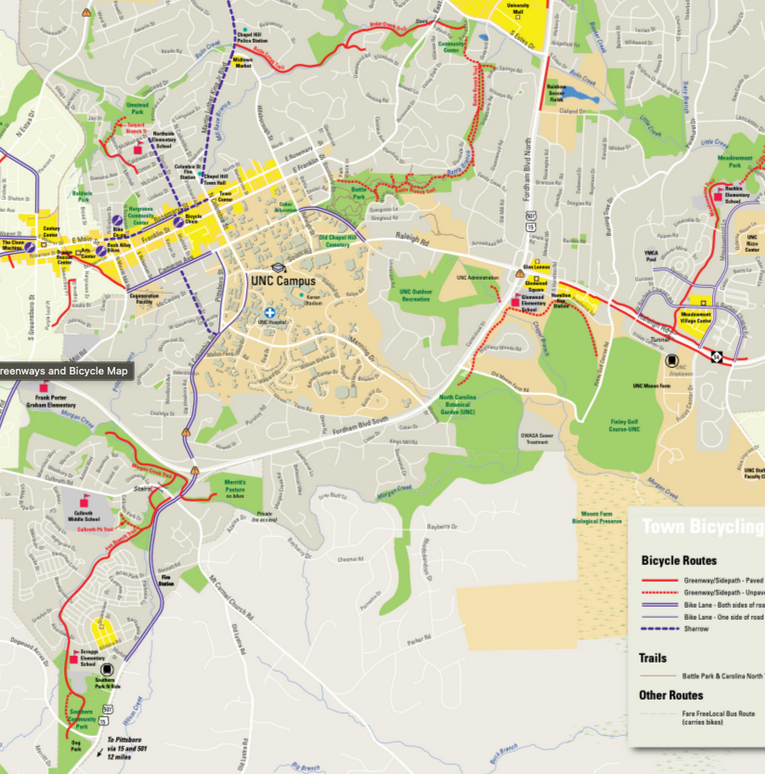
For people coming on foot or bike from the east there aren’t very good options. Currently, people trying to access Merritt’s Pasture from the east have to cut through private property. And unless you have a mountain bike, it’s not possible to get from the current end of the Morgan Creek Greenway (at Merritt’s Pasture) to Morgan Creek Road, just under a half-mile away, without walking your bike most of the way.
Discussions around the Morgan Creek Greenway
On Tuesday, March 19, the Parks, Recreation, and Greenways Commission met to discuss the plans to extend Morgan Creek Greenway to the east, creating another connection to Merritt’s Pasture. Last year, Chapel Hill allotted $500,000 from the town’s share of American Rescue Plan Act funds to pay a consultant to design the project.
Since October of last year, the consultant, McAdams Engineering, which has designed other greenways in town, has been working with the Department of Parks and Recreation to come up with a plan.
Even though the town recently established an Office of Mobility and Greenways, the planning for this greenway has been led by a different department. We’re not sure why, but wonder if it has something to do with the fact that Merritt’s Pasture is considered to be under the purview of the Parks and Recreation department.
But creating this connection has benefits that go far beyond allowing more people to spend a sunny afternoon on Merritt’s Pasture. Morgan Creek Greenway is currently connected to Fan Branch Greenway, which goes all the way to Southern Village. Chapel Hill is also planning to extend the Morgan Creek Greenway to the west, with Carrboro picking up the project at Smith Level Road and connecting many apartments that currently do not have easy access to green space with what will be a robust trail network. Creating this short connection to the east will allow people to get to UNC’s campus along Manning Drive, the N.C. Botanical Garden, and, through a few easy short cuts, all the way to Meadowmont, even Blue Hill, all on bike paths or neighborhood streets.
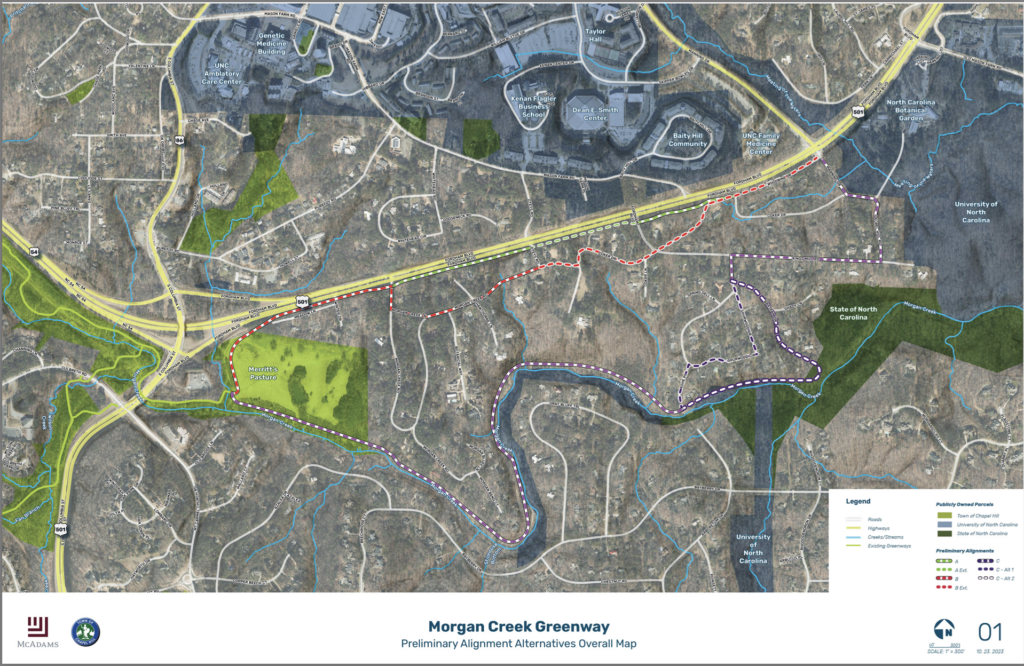
The town considered three options. Only two are viable. And only one is reasonably priced.
Greenways are, we’ve noted before, multi-solving. They provide access to nature, they reduce carbon emissions, they function as active transportation networks.
This also means that there are many ways to imagine what a greenway should be. McAdams considered three possible ways to extend the Morgan Creek Greenway:
- (A) A greenway that connects Morgan Creek Greenway to Manning Drive via a side path along Highway 54.
- (B) A shorter greenway that connects Morgan Creek Greenway to Morgan Creek Road, and then uses neighborhood streets to get to Manning Drive.
- (C) A longer greenway that runs alongside Morgan Creek.
While we love greenways, we’re surprised the town considered option C, which would cost more (because it’s longer) and not provide many benefits when it comes to connectivity. UNC and Chapel Hill have worked together for decades to keep that part of Chapel Hill low density in order to preserve wildlife (you can’t even take your dog into the Mason Farm Biological Reserve, which is adjacent to the places depicted in the map above). Furthermore, as the study found, there are easements along Morgan Creek that would make it all but impossible to build a greenway there.
So, that leaves options A and B. Option A would cost almost $6 million, mostly because it’d involve working with NCDOT to build a side path alongside US 15-501.
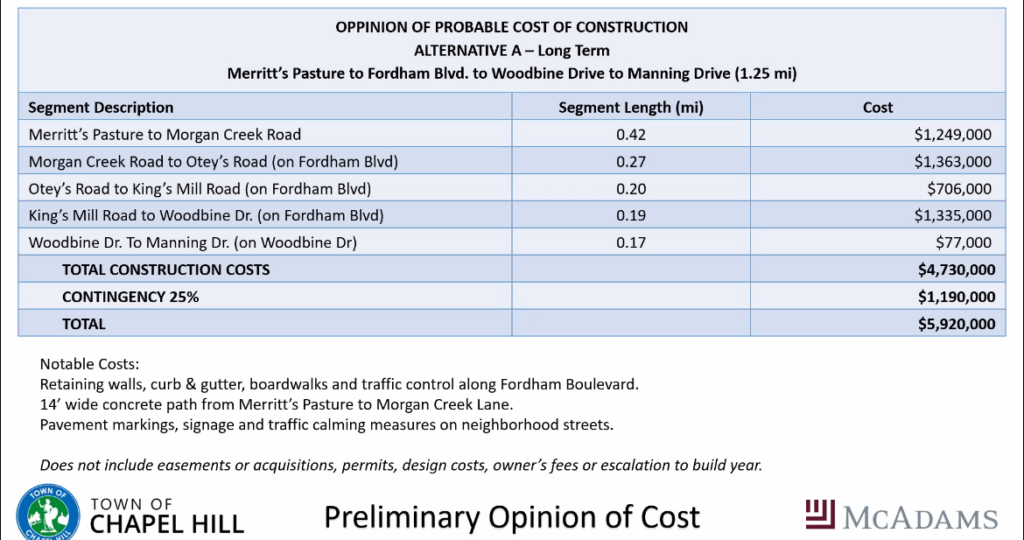
Meanwhile, option B is a third of the cost, and is just as safe, using neighborhood streets once you go to Morgan Creek Road. (Here’s a deeper dive on why we like Option B.)
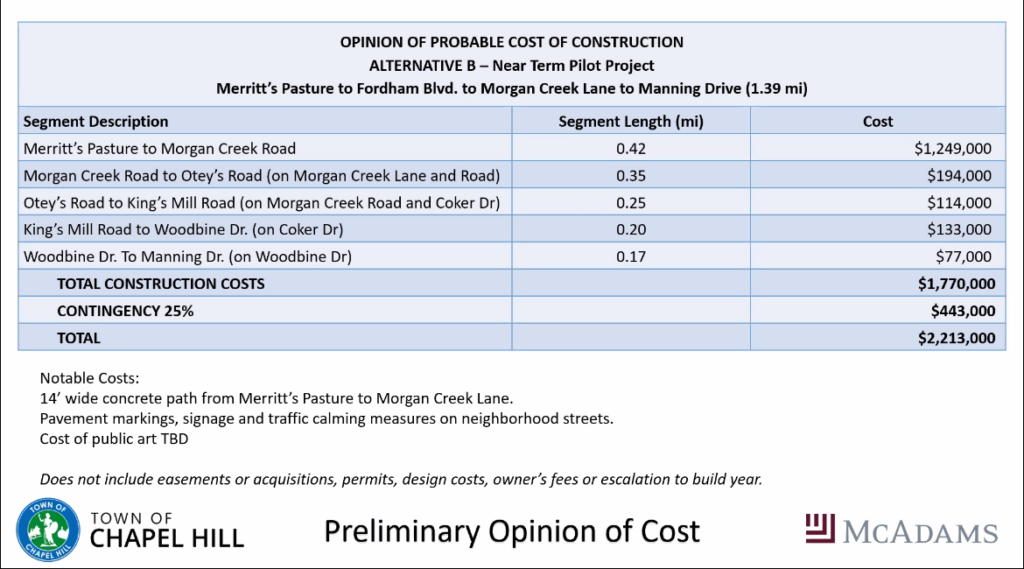
The town should use bond funds to pay for this.
Now that the town has a price tag for this project, the question becomes how to acquire the funds. While the town could try to get the federal government to pay for this small project, doing so would delay construction for years and add a lot of extra costs that come with any federal funding.
But with the town considering how best to allocate $50 million of bond funding, reserving a small amount for this greenway project, and possibly a few others, would help transform a series of mostly disconnected greenways in southern Chapel Hill into a greenway network that will have substantial benefits for our community.
Consider, for example, the following scenario. Imagine that this short greenway extension is built, the western extension of Morgan Creek Greenway (already funded) is built, and the NSBRT opens around the same time. Suddenly, the following becomes possible in 2030, just six years from now:
- A person moving to Chapel Hill to work at UNC Hospitals can live in the Canterbury Townhomes, a moderately priced townhome community in Carrboro, and use an e-bike to get to work. Instead of beginning and ending each day in a car, and paying $1,000 or more a year to park on campus, they can bike along Morgan Creek Greenway to Manning Drive, and then up Manning Drive.
- An international graduate student who lives in family housing at Baity Hill and doesn’t have a driver’s license can use the Morgan Creek Greenway to get to Weaver Street in Southern Village. Or they can bike to the NSBRT bus stop that will be built near the 54/15-501 bridge, which already has a connection to the Morgan Creek greenway, and take the bus to another grocery store. (The NSBRT buses will be big enough that you can just take your bike on board. No need to put it on the front rack.)
- An undergraduate who lives on South Campus and needs some time away from their dorm can walk to Merritt’s Pasture using the new greenway extension.
- A parent who lives in southern Chapel Hill, but uses the UNC daycare at the University Child Care Center at the Friday Center, can use a cargo e-bike to take their kid to daycare, using the Morgan Creek Greenway to get to Morgan Creek Road, and then bike on side streets to get to the bike path that goes all the way to the Friday Center. Instead of a 10-15 minute drive that will cost thousands of dollars a year in gas and wear and tear on their car, they’ll have an easy 20-minute bike ride that will also let them get some exercise.
There are countless other scenarios that become possible when we have a greenway network. While this short extension of the Morgan Creek Greenway may seem like a small project, it’s exactly what we need to be building if we really want an everywhere-to-everywhere greenway network.

